Lightning Strikes - Desert Truffles
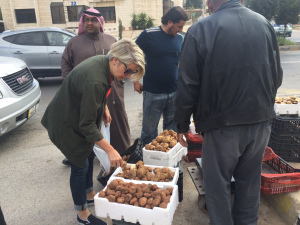 I don't know if you remember, but last March when we visited Amman I was rueing the fact that we'd just missed desert truffle season (see here). Called kima here, they are a springtime treat, looked forward to by locals and mired in ancient legend and folklore. This year, it seems the season started a little bit later and I've spotted piles of the gnarled brown orbs around town for almost a month now. I was determined to give them a try this season before they disappeared!My new friend Tala, expert on all things locally edible and an amazing cook, advised me to pick them myself, smell them, feel them, and go for the lighter colored ones with the fewest cracks and grooves possible. Sand burrows into the spongy flesh of these gems and those cracks make them very hard to clean. We were driving to visit the local Kitchen Aid showroom (my happy place) when I spied a display of the truffles at the side of the road. It was time to figure this fungus out.
I don't know if you remember, but last March when we visited Amman I was rueing the fact that we'd just missed desert truffle season (see here). Called kima here, they are a springtime treat, looked forward to by locals and mired in ancient legend and folklore. This year, it seems the season started a little bit later and I've spotted piles of the gnarled brown orbs around town for almost a month now. I was determined to give them a try this season before they disappeared!My new friend Tala, expert on all things locally edible and an amazing cook, advised me to pick them myself, smell them, feel them, and go for the lighter colored ones with the fewest cracks and grooves possible. Sand burrows into the spongy flesh of these gems and those cracks make them very hard to clean. We were driving to visit the local Kitchen Aid showroom (my happy place) when I spied a display of the truffles at the side of the road. It was time to figure this fungus out.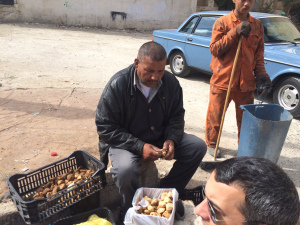 Eleven years ago the New York Times published a fantastic article on the mysterious dessert truffle out of Damascus, Syria. It breaks my heart a little bit to think of all the culture and food and history that has been lost over the past four years in their terrible civil war (not to mention the lives destroyed and lost). Apparently the Syrian desert was an amazing place to find these little gems, and the Bedouin's would wander far into Iraq as well (also not the safest place at the moment). The truffles sold in Amman this spring have been from Algeria primarily, closer sadly a place no one should go if they don't have to.
Eleven years ago the New York Times published a fantastic article on the mysterious dessert truffle out of Damascus, Syria. It breaks my heart a little bit to think of all the culture and food and history that has been lost over the past four years in their terrible civil war (not to mention the lives destroyed and lost). Apparently the Syrian desert was an amazing place to find these little gems, and the Bedouin's would wander far into Iraq as well (also not the safest place at the moment). The truffles sold in Amman this spring have been from Algeria primarily, closer sadly a place no one should go if they don't have to.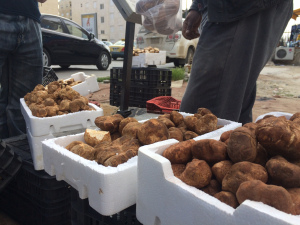 "These were once the food of the poor, now they're sought after by the rich," the man selling them to us said. He claims that truffles are God's way of feeding the poor. You see, thunder and lightning are credited for creating these nuggets in the sand. Bedouins say that it is the crevasses in the sand created by lightning strikes during the winter months and the rains that follow which allows the truffles to flourish and be harvested in the Spring. From God's gift to the merchant's cash cow as nowadays a the lesser quality truffles fetch 25 Jordanian Dinar (about $35) per kilo and he would only sell his higher quality product by the box-full and for about $300!
"These were once the food of the poor, now they're sought after by the rich," the man selling them to us said. He claims that truffles are God's way of feeding the poor. You see, thunder and lightning are credited for creating these nuggets in the sand. Bedouins say that it is the crevasses in the sand created by lightning strikes during the winter months and the rains that follow which allows the truffles to flourish and be harvested in the Spring. From God's gift to the merchant's cash cow as nowadays a the lesser quality truffles fetch 25 Jordanian Dinar (about $35) per kilo and he would only sell his higher quality product by the box-full and for about $300!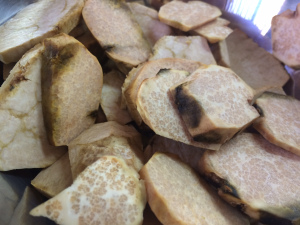 So these truffles are a distant relative of their fancy European cousins that you hear all the hoopla about in the foodie world. They're sort of a cross between a potato and a mushroom and slightly spongy and oddly veined inside. Apparently they are terrifically high in protein and while occasionally served in a stew with cubes of stewed lamb, it's not really necessary from a nutritional standpoint. Everyone told us they should be prepared simply, with sliced onions, maybe garlic, and that's it. I washed and peeled and chopped and soaked our little bounty, unable to tell what was sand, but sure I'd been as careful as I could about removing the grit. I chopped up several shallots, sauteed them in a generous amount of butter and then added my kima with lots of salt and pepper, a splash of white wine and finished with chives.
So these truffles are a distant relative of their fancy European cousins that you hear all the hoopla about in the foodie world. They're sort of a cross between a potato and a mushroom and slightly spongy and oddly veined inside. Apparently they are terrifically high in protein and while occasionally served in a stew with cubes of stewed lamb, it's not really necessary from a nutritional standpoint. Everyone told us they should be prepared simply, with sliced onions, maybe garlic, and that's it. I washed and peeled and chopped and soaked our little bounty, unable to tell what was sand, but sure I'd been as careful as I could about removing the grit. I chopped up several shallots, sauteed them in a generous amount of butter and then added my kima with lots of salt and pepper, a splash of white wine and finished with chives.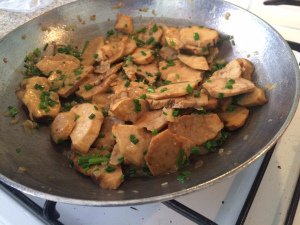 They smelled heavenly as they cooked, I had our Arabic bread at the ready, anticipating soaking up all of the earthy goodness....and while they tasted lovely and had the texture more reminiscent of an artichoke heart, the grit ruined my dish. Apparently I hadn't been thorough enough and needless to say, there's nothing less pleasant that chewing on sand. I did get a couple of hearty slices that were clean and delicious, but I'm afraid I'll have to get some pointers from a local on getting them completely clean. Stay tuned!
They smelled heavenly as they cooked, I had our Arabic bread at the ready, anticipating soaking up all of the earthy goodness....and while they tasted lovely and had the texture more reminiscent of an artichoke heart, the grit ruined my dish. Apparently I hadn't been thorough enough and needless to say, there's nothing less pleasant that chewing on sand. I did get a couple of hearty slices that were clean and delicious, but I'm afraid I'll have to get some pointers from a local on getting them completely clean. Stay tuned!